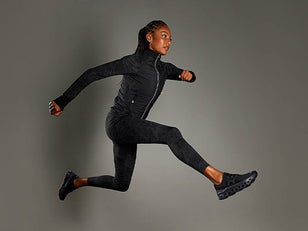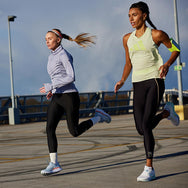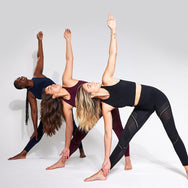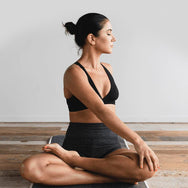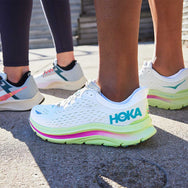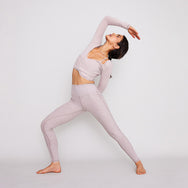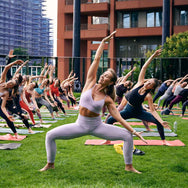Words by Ben Woodcock
Love it or hate it, stretching is essential for improving running performance. We caught up with sports physiotherapist Ben Lombard to discuss why stretching is so important and what particular stretches you should be incorporating into your pre and post running routine.

WHY DO RUNNERS NEED TO STRETCH?
Steadily increases heart rate
By stretching before a long or short run you can steadily, and controllably, increase your heart rate before you hit the ground running. Without this period of stretching, your heart rate will experience a more intense spike when you step out of the door and begin covering some miles. This will mean it takes longer for the body to adapt to the onset of exercise.
Stretching improves performance
Hopefully, it comes as no surprise that warm muscles respond best to any physical demands placed upon them. Increased blood flow to the working muscles, because of stretching routines, helps to warm muscles and make them more pliable. When running, this will result in a more natural, open stride.
As well as the stretches listed later, physio Ben Lombard recommends activation exercises such as leg swings, walking lunges, high knees and jumping jacks to give yourself an advantage before you go out for a run.
Reduces injury risk
Similarly, warmer and more flexible muscles help to avoid unnecessary muscle tears. If you were to head out for a 5k, particularly on a cold December morning, without spending 5-10 minutes stretching dynamically you are taking the risk of a pulled hamstring that could leave you side-lined for a couple of weeks.
So, factor in 10 minutes before your run to ensure you’re fit and firing for next time. Don’t see stretching as an add on to your running session, class it as part of the course to lubricate your joints and activate your nervous system.
Minimises impact of existing injuries
If you’re already feeling the impact of previous running sessions, you might wonder how stretching that area out before another workout would make you feel more comfortable.
Ben says: “A warm-up before a run can reduce injury risk by increasing blood flow to the area, which will warm the muscle and surrounding soft tissue giving the muscle greater flexibility whilst contracting and relaxing.”
Aids recovery
Not only should you set 10 minutes aside to stretch before your running activity, if you want to maximise recovery and ability to keep the pace on your next run you should find time afterwards too.
Ben says: “After a run stretching can help ease tight muscles and remove lactate. Dynamic stretching can also be useful here to help provide blood flow to the used muscles to aid the recovery process.”

DYNAMIC STRETCHING vs. STATIC STRETCHING
It’s an age-old debate, what method of stretching is better for the body? While everybody has their own preference and that’s fine, scientifically it is thought that dynamic stretches are more beneficial.
Ben says: “When it comes to pre-run routine I prefer to start with dynamic stretches, specific muscle activation and general heart elevation.”
“I personally prefer dynamic stretching as there is limited research of the efficacy of static stretches. However, many people report therapeutic effects of static stretches. In practice I find static stretches useful for increasing static ranges of motion but if you plan of using those ranges actively then dynamic movements will be more useful.”

10 STRETCHES EVERY RUNNER SHOULD DO
Lower Back Stretch
Static: The back stretch- While sitting on the floor, place the soles of your feet together.
- Place your arms under your legs, from the inside of your legs and reach for the tips of your feet.
- Fully roll your back and head forward to target the lumbar muscles.
- 1 minute.
- Place hands flat on the floor and stretch out arms keeping them in line below your shoulders.
- Place your knees on the ground, below your hips.
- Flex and extend back into cat/cow positions.
- Complete for 1 minute.
Hamstring Stretch
Static: Seated hamstring stretch- Sit on the floor while keeping your legs straight and parallel
- Roll and relax your back forwards.
- Grab your feet, alternatively try to reach your ankles/shins based on mobility level.
- 1 minute.
- Lie on your back with one leg slightly bent with your heel of the same leg on the ground.
- Keep your other leg extended.
- Squeeze your glutes and abdominals to raise your straight leg off the floor.
- 1 minute each side

Hip Flexor Stretch
Static: Twisted hip opener- Get into a wide front lunge position.
- Bend the knee of your rear leg and grab this leg with your opposite hand.
- Place your other hand on the floor to maintain balance.
- 1 minute each side.
- Alternate leg each time.
- When opening ‘the gate’ raise and bend your knee parallel to the body.
- Then, open the angle of your hip to 45 degrees before lowering and extending leg.
- To ‘close the gate’ perform this action in reverse; raise and bend your knee at 45 degrees from parallel, then close the angle at the joint until leg is back in a parallel position.
- 30 seconds open and 30 seconds close.
Calf Stretch
Static: Single leg calf stretch on wall- Place your toes elevated against a wall with your heel on the ground, this should create a triangle between the wall and your foot.
- Keep your heel as close to the wall as possible.
- Push your hips forward towards the wall while keeping both legs straight.
- 1 minute each side.
- Stand on a safe step, the bottom step of your stairs for example. Make sure you hold onto something stable while performing this stretch.
- Place just the front half of your feet on the step, with the back half off the step.
- Contract your calves in phase one of the movement.
- Relax your calves in phase two of the movement, this should mean your heels go lower than the step you are standing on.
- 1 minute.
Piriformis Stretch
Static: Seated piriformis stretch- Sit on the floor with one leg extended and the other bent at the knee.
- Cross your bent knee over the opposite leg and pull your knee towards your shoulder.
- Keep back flat and torso facing crossed leg.

THE TAKEAWAY
Whether you feel static or dynamic stretches suit you, chose whichever makes you feel ready. What’s important is that you spend the time before and after your run to ensure you improve and maintain your performance while looking after your muscles.
We all have the urge to jump straight into any workout whether it’s in the gym or out on the roads and tracks running. And if you asked any athlete what the most boring part about their training is, most would say stretching, but they would also add it that it's the most important area of their training to improve range of motion and avoid injuries.




















